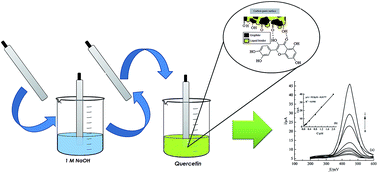当前位置:
X-MOL 学术
›
Anal. Methods
›
论文详情
Our official English website, www.x-mol.net, welcomes your
feedback! (Note: you will need to create a separate account there.)
Development of a novel voltammetric sensor for the determination of quercetin on an electrochemically pretreated carbon-paste electrode
Analytical Methods ( IF 2.7 ) Pub Date : 2018-02-19 00:00:00 , DOI: 10.1039/c7ay02953e Konstantin Pliuta 1, 2, 3, 4, 5 , Alexander Chebotarev 1, 2, 3, 4, 5 , Anastasiya Koicheva 1, 2, 3, 4, 5 , Kateryna Bevziuk 1, 2, 3, 4, 5 , Denys Snigur 1, 2, 3, 4, 5
Analytical Methods ( IF 2.7 ) Pub Date : 2018-02-19 00:00:00 , DOI: 10.1039/c7ay02953e Konstantin Pliuta 1, 2, 3, 4, 5 , Alexander Chebotarev 1, 2, 3, 4, 5 , Anastasiya Koicheva 1, 2, 3, 4, 5 , Kateryna Bevziuk 1, 2, 3, 4, 5 , Denys Snigur 1, 2, 3, 4, 5
Affiliation

|
In this work, a simple, cheap and sensitive sensor for quercetin voltammetric determination was developed. Quercetin is a flavonoid that is widely distributed in plants. The antioxidant, anti-cancer, antibacterial and anti-inflammatory activities of quercetin make it an important biologically active substance. Therefore, the development of new methods for its rapid and inexpensive determination is an urgent task. The presence of a large number of hydroxyl groups in quercetin makes its accumulation possible due to hydrogen bonding. Using the electrochemical activation of a carbon-paste electrode, a sensor with great ability for quercetin adsorption has been developed. Using the proposed sensor, the electrochemical behavior of quercetin has been investigated. The adsorption nature of the current was established. After pre-accumulation on the sensor, quercetin is oxidized reversibly. Using SWVs under optimal conditions (electrochemical pretreatment of the CPE was carried out in 1 M NaOH solution at 1.5 V for 120 seconds; quercetin adsorption at 0 mV for 300 s from Britton–Robinson buffer solution with pH 3 and a sweep rate of 200 mV s−1, an amplitude of 50 mV, and a frequency of 30 Hz), it is possible to determine quercetin in the concentration range of 0.06–2 μM, with the LOD and LOQ equal to 1.6 × 10−3 μM and 5.2 × 10−3 μM, respectively, and a sensitivity of 19.9 μA μM−1. The developed sensor was satisfactorily used for the determination of quercetin in pharmaceuticals and extracts of green and black tea with a RSD of 3.5%.
中文翻译:

新型伏安传感器的开发,用于在电化学预处理的碳糊电极上测定槲皮素
在这项工作中,开发了一种简单,便宜且灵敏的槲皮素伏安法测定传感器。槲皮素是一种类黄酮,广泛分布于植物中。槲皮素的抗氧化,抗癌,抗菌和抗炎活性使其成为重要的生物活性物质。因此,开发新的方法以快速,廉价地进行测定是当务之急。槲皮素中大量羟基的存在使得其由于氢键的结合成为可能。利用碳糊电极的电化学活化,已经开发了具有槲皮素吸附能力的传感器。使用所提出的传感器,已经研究了槲皮素的电化学行为。确定了电流的吸附性质。在传感器上预先积累后,槲皮素可逆地被氧化。在最佳条件下使用SWV(CPE的电化学预处理在1.5 V的1 M NaOH溶液中进行120秒;从pH 3的Britton-Robinson缓冲溶液在0 mV的槲皮素吸附300 s,扫描速率为200 mV s-1,50毫伏的幅度,和30赫兹的频率),有可能确定在0.06-2μM的浓度范围槲皮素,与LOD和LOQ等于1.6×10 -3微米至5.2×10 -3 μM,分别和19.9μAμM的灵敏度-1。该开发的传感器可令人满意地用于测定药品和绿茶和红茶提取物中的槲皮素,相对标准偏差为3.5%。
更新日期:2018-02-19
中文翻译:

新型伏安传感器的开发,用于在电化学预处理的碳糊电极上测定槲皮素
在这项工作中,开发了一种简单,便宜且灵敏的槲皮素伏安法测定传感器。槲皮素是一种类黄酮,广泛分布于植物中。槲皮素的抗氧化,抗癌,抗菌和抗炎活性使其成为重要的生物活性物质。因此,开发新的方法以快速,廉价地进行测定是当务之急。槲皮素中大量羟基的存在使得其由于氢键的结合成为可能。利用碳糊电极的电化学活化,已经开发了具有槲皮素吸附能力的传感器。使用所提出的传感器,已经研究了槲皮素的电化学行为。确定了电流的吸附性质。在传感器上预先积累后,槲皮素可逆地被氧化。在最佳条件下使用SWV(CPE的电化学预处理在1.5 V的1 M NaOH溶液中进行120秒;从pH 3的Britton-Robinson缓冲溶液在0 mV的槲皮素吸附300 s,扫描速率为200 mV s-1,50毫伏的幅度,和30赫兹的频率),有可能确定在0.06-2μM的浓度范围槲皮素,与LOD和LOQ等于1.6×10 -3微米至5.2×10 -3 μM,分别和19.9μAμM的灵敏度-1。该开发的传感器可令人满意地用于测定药品和绿茶和红茶提取物中的槲皮素,相对标准偏差为3.5%。











































 京公网安备 11010802027423号
京公网安备 11010802027423号